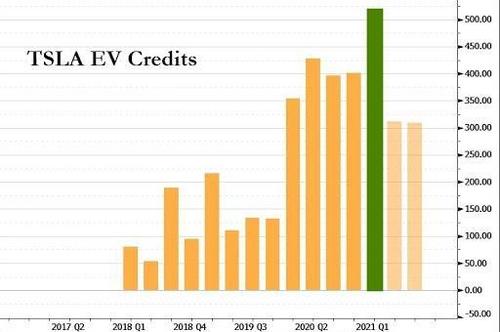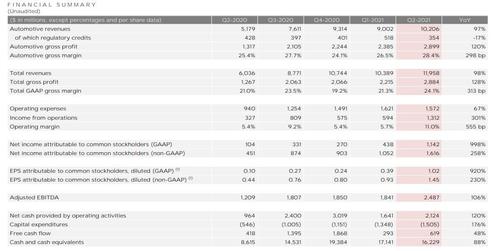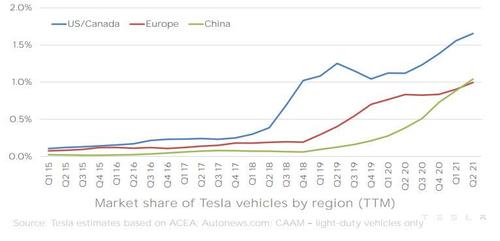Tesla Jumps After Beating Expectations, Says Shanghai Is Now Main Hub For Auto Exports
Heading into Tesla's Q2 earnings, in our preview earlier we noted that sentiment is optimstic and the outlook for Q2 is pretty good because despite grappling with the chip shortage, a customer backlash in China, and the same shipping bottlenecks plaguing all global automakers right now, Tesla managed to set a record for vehicle deliveries in the second quarter: 201,250 cars.
As Bloomberg notes in its earnings preview, analysts have honed in on that bullish feat, and the idea that Tesla has been raising prices periodically throughout the year. Like the rest of its automotive peers, tight supply is giving Tesla some extra pricing power and the ability to pad margins amid costly supply chain headaches and raw material spikes.
On the bearish side, questions as usual will swirl about the source of Tesla's profitability: as noted last quarter, virtuallyall of the company's profits came from the sale of zero-emission regulatory credits which Tesla sells to other automakers (i.e., Jeep owner Stellantis). It basically equates to 100% margin and has been a significant contributor to net income. But, as Bloomberg notes, it can’t last forever.
For those who need a refresh, this is how much TSLA has sold in regulatory credits:
- 1Q 2020: $354M
- 2Q 2020: $428M
- 3Q 2020: $397M
- 4Q 2020: $401M
- 1Q 2021: $518M
And visually:
Also it's worth recalling that this is Tesla’s first earnings call since Elon Musk feisty appearance earlier this month in Delaware Chancery Court over the automaker’s controversial 2016 acquisition of SolarCity. Musk contended that the acquisition was a sound decision -- that it wasn’t done to benefit himself instead of shareholders.
In any case, as we enter Tesla's earnings, we have record deliveries, rosy outlook on the quarter (albeit with questions about how the company generates its profit). And yet, Tesla’s stock is down 7.2% this year, while the S&P Index it belongs to is up nearly 18%. Clearly investors are a little concerned about the company's long-term prospects at a time when virtually every OEM is coming up with numerous EV offerings and investing billions in future capacity.
With that in mind, here is how Tesla did in the second quarter as per the just released investor letter:
- Revenue $11.96B, beating the est $11.36B
- Adjusted EPS $1.45, beating the est 97c
- Free Cash Flow $619M, beating the estimate of a Negative $319.1M
- Automotive gross margin 28.4%, beating the estimate of 25.0%
- Cash and cash equivalents of $16.229BN, missing the estimate $16.55 billion
The result visually:
Of note, unlike previous quarter when virtually all the profit came from the sale of regulatory credits, in Q2 the situation normalized somewhat with $354MM from regulatory credits, which represents about 30% of the GAAP Net Income of $1.142BN, and is well lower than the $518MM in Q1.
The company also reported what we already knew - that it produced and delivered over 200,000 vehicles, while achieving an "operating margin of 11.0% and exceeded $1B of GAAP net income for the first time in our history." However, as noted above, of this more than a third was from the sale of regulatory credits.
Looking ahead, Tesla suggested deliveries this year may exceed its longer-term projections for 50% growth, writes Bloomberg’s Dana Hull.
Tesla is expanding on three continents, including constructing new factories in Austin, Texas, and Berlin. The company confirmed a forecast for 50% growth in deliveries “over a multiyear horizon,” but added, “in some years we may grow faster, which we expect to be the case in 2021.”
Other highlights: In Tesla's comments on revenue, which rose 98% Y/Y, we find that the company's average selling prices in Q2 declined by 2% Y/Y - which is odd at a time when car prices are exploding higher - which the company said was "due to the product updates and as lower ASP China-made vehicles became a larger percentage of our mix." The full comment:
Total revenue grew 98% YoY in Q2. This was primarily achieved through substantial growth in vehicle deliveries, as well as growth in other parts of the business. At the same time, vehicle ASP1 declined by 2% YoY as Model S and Model X deliveries were reduced in Q2 due to the product updates and as lower ASP China-made vehicles became a larger percentage of our mix.
Tesla also notes that "due to strong U.S. demand and global average cost optimization, we have completed the transition of Gigafactory Shanghai as the primary vehicle export hub." In other words, as Bloomberg notes, they’re making all they can sell in the U.S., so to export to the rest of the world, it’s going to come from China (until the Austin and Berlin factories are ready).
Looking at profit next, the company attributes the beat to volume growth and driving costs down, while recording a “Bitcoin related impairment” of $23 million. There were a few other headwinds to overcome: supply chain costs as well as lower regulatory credit revenue.
Our operating income improved in Q2 compared to the same period last year to $1.3B, resulting in an 11.0% operating margin. This profit level was reached while incurring SBC expense attributable to the 2018 CEO award of $176M in Q2, driven by a new operational milestone becoming probable.
Operating income increased YoY mainly due to volume growth and cost reduction. Positive impacts were partially offset by growth in operating expenses including increased SBC, Model S/X ramp (negative margin in Q2), additional supply chain costs, lower regulatory credit revenue, Bitcoin-related impairment of $23M and other items.
How about the balance sheet? Here Tesla reported $16.2BN in cash, which decreased mainly driven "by net debt and finance lease repayments of $1.6B, partially offset by free cash flow of $619M."
Reading further in the shareholder deck, we find that Tesla believes it remains "on track to build our first Model Y vehicles in Berlin and Austin in 2021." One reason Tesla wants Berlin online ASAP is that demand in Europe appears strong:
"While our global production lines continue to run as fast as possible, European demand remains well above supply, resulting in growing wait times for delivery."
And speaking of European demand, here’s a snapshot of Tesla’s market share of vehicles in three major regions.
How about China? According to Wedbush analsyst Dan Ives, “while more will come out on the conference call later tonight, it appears the China growth story looks healthy into 2H (despite some 2Q speed bumps) with all eyes on Musk’s commentary around the chip shortage, battery technology, Model Y deliveries, and the Bitcoin impact."
Now the not so good news: Tesla has shifted the launch of the semi truck program to 2022, citing “limited availability of battery cells and global supply chain challenges” in its decision to delay the launch of its semi truck product. The company also did not give any timeline for its Cybertruck, other than it will happen in Austin “subsequent to Model Y.”
Meanwhile, the company's energy business is slowing: Tesla’s solar deployments slipped to 85 megawatts in 2Q from 92 megawatts in the first period of this year. There was little update on the Solar Roof besides this: “Solar Roof deployments grew substantially both YoY as well as sequentially in Q2.”
Finally, looking at its funding needs, Tesla said that it has "sufficient liquidity to fund our product roadmap, long-term capacity expansion plans and other expenses." So no capital raises any time soon.
In kneejerk reaction the stock jumped as much as 3% on what appears to be a solid beat on revenue, earnings and Free Cash Flow, however it has since faded much of the gains, giving a negative answer to those wondering if this earnings report will be the one that finally send TSLA stock green for the year.
https://ift.tt/3zA0fqP
from ZeroHedge News https://ift.tt/3zA0fqP
via IFTTT







0 comments
Post a Comment